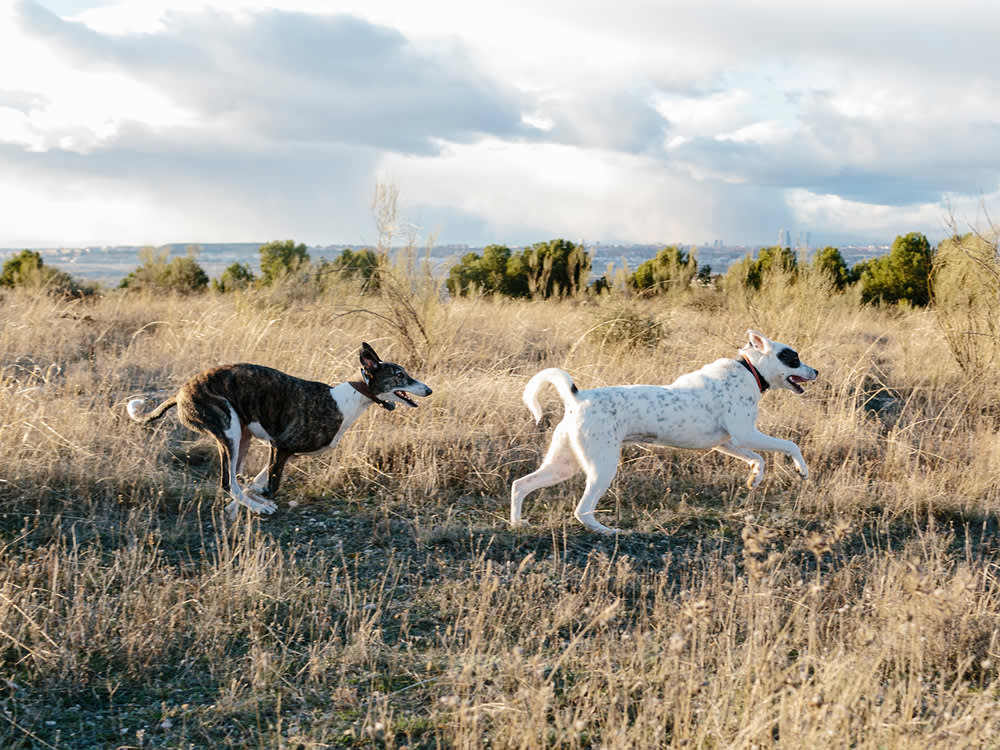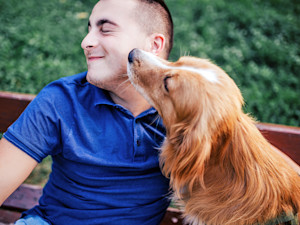Don’t Worry, But Dogs Can Get Cancer From Sniffing Other Dogs’ Nether-Regions
The gnarly scoop on canine transmissible venereal tumors.
OK, this isn’t going to be the prettiest picture, but, uh, imagine this: Charlie, a handsome 2-year-old un-neutered male mixed breed dog, gets his lucky break and is taken off the streets into a new, loving home. Several weeks after adoption, he is constantly licking his prepuce (the sheath around his penis) and his breath is pretty funky.
During a physical exam, your vet pulls back his prepuce and exposes a gnarly, lumpy tumor at the base of his penis. After testing, your new pup is diagnosed with canine transmissible venereal tumors.
Snap a pic of your pup’s teeth, and GREENIES™ will help you spot potential signs of oral health issues.
How does sexually transmitted cancer happen?
Canine transmissible venereal tumors (TVT) are contagious tumors that spread between dogs through direct contact. Typically, dogs acquire TVT through sexual intercourse, but any skin-to-skin contact with affected tissue can allow cancerous cells to be transferred. Once the cells are transplanted, they will progress into tumors in the area of contact.
Canine transmissible venereal tumors typically start off as a small lump on the penis or vulva. The lump grows quickly, leading to irritation that prompts the dog to lick the affected skin. Licking causes further irritation, which leads to bleeding, oozing, and foul odor. Genitalia are not the only area where dogs can get TVT. The tumors can also develop on the face, nose, and mouth after dogs sniff the genitals of other dogs with the disease.
How much do you spend on your pet per year?
How do some dogs end up with a sexually transmitted tumor on their face?
Some dogs only develop TVTs in their nose and mouth, in a condition called primary oronasal canine transmissible venereal tumors. Researchers at Cambridge University recently published an articleopens in new tab stating that “male dogs are at four-to-five times greater risk of primary oronasal CTVT than female dogs.” The researchers used a database compiled over 10 years that contains almost 2000 cases of TVT. They narrowed the cases down to those that involved nose and mouth tumors only — a total of 32. Of these 32 cases, over eighty percent (27 cases) occurred in male dogs.
It’s normal for dogs to sniff butts when they say hello, why the discrepancy between male and female dogs? Researchers attributed this difference to anatomical and behavioral discrepancies. Male dogs sniff the genitals of female dogs to determine if they are in heat and ready to mate. The study says, “female genital CTVT [tumors] tend to be more exposed and accessible for licking or sniffing than those of males, which are usually enclosed in the prepuce. Thus, the external location of female genitalia CTVT [tumors], coupled with a likely male preference for licking and sniffing female genitalia, may contribute to increased risk of oronasal CTVT in males.”
Overall, primary oronasal canine transmissible venereal tumors are relatively rare and made up only two percent of the cases in the database used in the study.
How can we tell canine transmissible venereal tumors apart from other lumps and bumps?
Diagnosis is based on the dog’s history, physical examination, and tissue sampling. Dogs allowed to roam, exposed to stray dogs, or used for breeding have an increased risk of contracting TVT. The appearance and location of the tumors tend to be a giveaway as well — irregular, ulcerated lesions on the genitals have a limited number of causes.
Dogs with primary oronasal tumors may experience sneezing, nose bleeds, drooling, bad breath, and tooth loss. Diagnosis is confirmed using fine-needle aspirate and cytology or biopsy. Once confirmed, a treatment plan is formed.
What can be done for dogs diagnosed with canine transmissible venereal tumors?
The good news is that TVTs are extremely treatable and carry a great prognosis with appropriate treatment. Chemotherapy is the treatment of choice for TVT. Weekly injections of vincristine, a chemotherapy drug, over the course of several weeks usually succeed in causing tumors to regress. Radiation is a treatment option for tumors that don’t respond to chemotherapy.
Surgery can be used to remove smaller tumors but is rarely chosen since it’s difficult to get clean, wide margins on such sensitive areas (we are talking about the genitals, after all). In summary, don’t worry when your dog goes to greet the neighboring pup with its usual “hello” — just, like all ailments that could befall your best friend, be aware.








